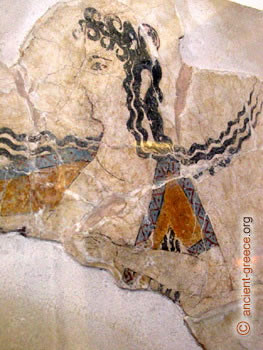
MINOAN: The Minoans raised cattle, sheep, pigs, goats, and grew wheat, barley, vetch, chickpeas, figs, olives, and grapes.Farmers used wooden plows, bound by leather to wooden handles, and pulled by pairs of donkeys or oxen.
MYCENAEAN: It is obvious that the Mycenaean economy was based on agriculture. The tablets from both Pylos and Knossos demonstrate that there were two major food-grains produced; wheat and barley.The land used for agriculture was basically of two types, represented by the terms ko-to-na (ktoina) ki-ti-me-na and ko-to-na ke-ke-me-na.Except from cereals, the Mycenaeans also produced wine, olive oil, oil from various spices and figs. As far as wine is concerned, it does not figure in the ordinary ration lists and may have been something of a luxury or possibly for export.
MYCENAEAN: It is obvious that the Mycenaean economy was based on agriculture. The tablets from both Pylos and Knossos demonstrate that there were two major food-grains produced; wheat and barley.The land used for agriculture was basically of two types, represented by the terms ko-to-na (ktoina) ki-ti-me-na and ko-to-na ke-ke-me-na.Except from cereals, the Mycenaeans also produced wine, olive oil, oil from various spices and figs. As far as wine is concerned, it does not figure in the ordinary ration lists and may have been something of a luxury or possibly for export.

